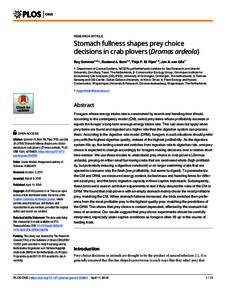Document
Stomach fullness shapes prey choice decisions in crab plovers (dromas ardeola).
Identifier
DOI: 10.1371/journal.pone.0194824
Source
PLoS ONE. v. 13, 4, e0194824
Contributors
Country
United States.
Publisher
Public Library of Science.
Gregorian
2018-04-01
Language
English
Subject
English abstract
Foragers whose energy intake rate is constrained by search and handling time should, according to the contingency model (CM), select prey items whose profitability exceeds or equals the forager’s long-term average energy intake rate. This rule does not apply when prey items are found and ingested at a higher rate than the digestive system can process them. According to the digestive rate model (DRM), foragers in such situations should prefer prey with the highest digestive quality, instead of the highest profitability. As the digestive system fills up, the limiting constraint switches from ingestion rate to digestion rate, and prey choice is expected to change accordingly for foragers making decisions over a relative short time window. We use these models to understand prey choice in crab plovers (Dromas ardeola), preying on either small burrowing crabs that are swallowed whole (high profitability, but potentially inducing a digestive constraint) or on larger swimming crabs that are opened to consume only the flesh (low profitability, but easier to digest). To parameterize the CM and DRM, we measured energy content, ballast mass and handling times for different sized prey, and the birds’ digestive capacity in three captive individuals. Subsequently, these birds were used in ad libitum experiments to test if they obeyed the rules of the CM or DRM. We found that crab plovers with an empty stomach mainly chose the most profitable prey, matching the CM. When stomach fullness increased, the birds switched their preference from the most profitable prey to the highest-quality prey, matching the predictions of the DRM. This shows that prey choice is context dependent, affected by the stomach fullness of an animal. Our results suggest that prey choice experiments should be carefully interpreted, especially under captive conditions as foragers often ‘fill up’ in the course of feeding trials.
ISSN
1932-6203
Category
Journal articles

